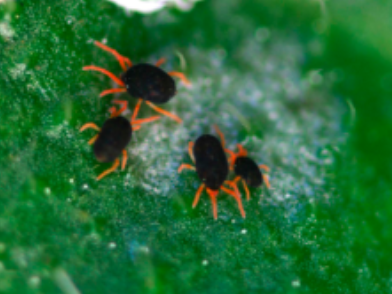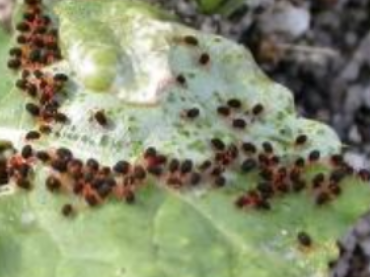Show us your mite: tackling a red-legged pest
06 Oct 2021
 PRODUCTION ADVICE - OCTOBER 2021 - INVASIVE SPECIES
PRODUCTION ADVICE - OCTOBER 2021 - INVASIVE SPECIES
By Adrian Smith
Senior Land Services Officer - Mixed Farming Systems
P: 03 5881 9932 | M: 0447 778 515 | E: adrian.smith@lls.nsw.gov.au
 Red-legged earth mites (RLEM) (Halotydeus destructor) are significant pests of grain crops and pasture across NSW.
Red-legged earth mites (RLEM) (Halotydeus destructor) are significant pests of grain crops and pasture across NSW.
While autumn and winter are typically the times when we can see damage from infestations, we can still see significant numbers (and resulting damage) as we move through spring.
Warm (not hot) and moist conditions, which many are experiencing this spring, are ideal conditions for RLEM. In pastures, for example, where we are trying to maximise spring growth and seedset, RLEM activity can have serious impacts.
Ongoing monitoring coupled with targeted action will help keep numbers in check, minimise impacts on crops and pastures and, importantly, help to reduce egg-laying so helping to reduce numbers next autumn.
What do RLEM look like?
Most producers will have seen RLEM in their paddocks. They are part of the mites (Acarina) family, which, because of their extensive habitat and small visual size, can be difficult to identify.
Like other mites in the family, RLEM have nymph and adult life cycle stages. They have initially six pinkish/orange legs. They undergo three nymphal stages to reach adulthood and a full body length of 1 millimetre, which is oval-shaped and velvety black in colour. During the nymphal stages they gain two more legs to have eight distinctive red legs by maturity.
The most important distinguishing characteristic of RLEM is that they generally tend to feed in groups or clusters.
When looking for RLEM, look at the leaves of the plant first, and if mites cannot be spotted, observe the soil surface, as RLEMs will often be sheltering in leaf sheaths and under soil debris when conditions are warmer. Observing the same few plants or patch of ground for 10-15 seconds should be enough time to spot mites moving around if they are present.
What are the signs of damage?
Most damage is done to crops and pastures by RLEM at establishment, which reduces the seedling development and long-term survival. Monitoring for RLEM should occur regularly in crops three weeks after emergence. However, in spring, pastures can also be susceptible, particularly legumes.
Seed set can be impacted by heavy feeding damage if RLEM thresh old control levels are not kept to a minimum. RLEM affect a large variety of crops, including canola, cereals (wheat, barley, oats), lupins, faba beans, field peas, sunflowers, lucerne, vetch, some grasses and pasture legumes.
old control levels are not kept to a minimum. RLEM affect a large variety of crops, including canola, cereals (wheat, barley, oats), lupins, faba beans, field peas, sunflowers, lucerne, vetch, some grasses and pasture legumes.
Many weed species such as capeweed and Paterson’s curse are hosts for RLEM.
The most noticeable features of RLEM in-crop damage are caused by their feeding and are seen as silvering or a white discolouration of leaves. The silvering is often mistaken for frost damage, as shown in Figure 2, right. Where infestations are severe, plant leaf distortion and shrivelling or death of young seedlings will also occur.
The key is to get out in your paddocks and look. The best times to check for mites are in the mornings, when mites are feeding on leaves, and on overcast days. As the day warms up, the mites take shelter in the leaf sheaths of plants and in organic debris.
What are the control options?
To help manage resistance issues of mites to some pyrethroid chemical options, producers and their advisors should use thresholds to assist with decisions around control actions and types of chemicals.
It is important to note that some crops including wheat and canola have shown, under some circumstances, to have the ability to compensate for crop damage from RLEM. Therefore, working to thresholds becomes important before using an insecticide or miticide, and your choice of varieties is also important if you have a known paddock history of RLEM problems.
There is a range of chemical, biological and management control options.
Long-term control strategies
Knowing the lifecycle of the RLEM can help to exploit its weaknesses. This gives producers control options and time for careful monitoring for early intervention to minimise the mite damage.
A long-term control strategy is to use the Australian Wool Innovation (AWI) Timerite® system developed by CSIRO.
Timerite® provides the optimum spray date in spring for your property. This date is unique for each location and remains constant from year to year.
Using the Timerite® spray date will remove females before they produce their eggs, significantly reducing the number of mites hatching next autumn. Producers simply need to access the website - www.wool.com/land/timerite/calculatedate/ - enter the precise location of their paddock(s) (latitudes and longitudes) into the Timerite® calculator, and it will provide ideal spray dates.
As we move into late spring, producers across the region should now be using the Timerite® advice to select the ideal time to spray pastures (particularly).
If you have any concerns, please speak to your local advisor, agronomist or members of the Agriculture team at Murray Local Land Services: 1300 795 299. Alternatively, the GRDC has an excellent publication which producers should familiarise themselves with around managing RLEM - click here to download.